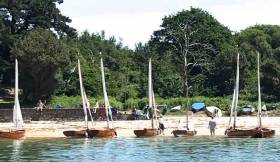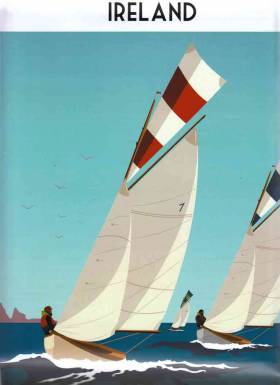Displaying items by tag: Morbihan
Kilrush Skiff Sailors Discover Dublin Bay Water Wags Have Become Icons Of France's Morbihan Classics
The St Ayles skiff Ealu, new-built by Seol Sionna in Kilrush, has been entered for this year's edition of the vast and deservedly legendary Semaine du Golfe for traditional and classic boats at the Morbihan in Southern Brittany from May 15th to 21st 2023. And in so doing, the Sailors of the Shannon have revealed that when the Dublin Bay Water Wags attended in strength in France at the previous event in 2019, they didn't go unnoticed despite the huge size of the fleet. On the contrary, the unmistakable clinker-built hulls of five Water Wags in all their varnished glory feature prominently in the event banner at the head of the Morbihan event's promotional material
 Morbihan promotion via Dun Laoghaire. Beyond the blue hull, there are five immaculate Dublin Bay Water Wags as seen at La Semaine du Golfe in Southern Brittany in 2019
Morbihan promotion via Dun Laoghaire. Beyond the blue hull, there are five immaculate Dublin Bay Water Wags as seen at La Semaine du Golfe in Southern Brittany in 2019
STEVE MORRIS OF KILRUSH BOATYARD fills us in on the background and gives additional welcome news of the Shannon cutter Sally O'Keeffe:
"Éalú is entered into this year's Breton festival on the Morbihan, at present 10 Seol Sionna members will be travelling with her in mid-May, but that number may grow.
Yesterday, Saturday, February 25th February, we also started training for this year's Ocean to City race/rally at Cork in June with a lively row around Kilkee Bay, and weather permitting, we will be bringing Ealu to various spots on the Clare coast to continue our preparation for that event.
Our 25ft traditional cutter Sally O'Keeffe's mast is on the trestles for varnishing, and the other spars were beautifully varnished late last year by Max and Erwan from Skol ar Mor in Brittany while they were on three weeks of work experience with me in Kilrush - we hope to link up with them at the Golf de Morbihan event in May.
 Although "only" 25ft in overall hull length, the Myles Stapleton-designed Shannon cutter Sally O'Keeffe - community-built at Querrin near Kilrush - is versatile and roomy
Although "only" 25ft in overall hull length, the Myles Stapleton-designed Shannon cutter Sally O'Keeffe - community-built at Querrin near Kilrush - is versatile and roomy
Tentative plans were being discussed to attend this year's WIORA Championship in the Aran Islands from 5th to 8th July with Sally O Keeffe, as last year's event based out of Kilrush was thoroughly enjoyed by all the Sallys. Our usual crew training course based around Sally O Keeffe will of course, also go ahead this year.
Meanwhile, the skiff is wonderful at sea. Kilkee was lively on Saturday, but with six on board, we managed to easily row out to the mouth of the bay, yet there was barely a cupful of spray in the bilges when we got her back on the handy trailer after a two-hour session, a real endorsement of her Nordic design heritage and the concept refinements of Ian Oughtred and Alec Jordan".
Steve's mention of Skol ar Mor is a reminder that this Breton boat-building school, having created the new Howth 17 Footer Orla in 2018, has many other links with Ireland. And that in turn, reminds us that when the Howth 17s attended the Semaine du Golfe in 2015, they frequently found themselves in close proximity with the Eric Tabarly 43ft gaff cutter Pen Duick, a Fife design built at Carrigaloe on Cork Harbour in 1898.
 Pen Duick in the Morbihan with Howth 17s - the combined age of the boats in the photo must be nearly 500 years
Pen Duick in the Morbihan with Howth 17s - the combined age of the boats in the photo must be nearly 500 years
The intriguing story of how a ship’s gig of 1796 came to be quietly preserved in Bantry House is well known among classic and traditional boat enthusiasts writes W M Nixon. The elegant craft was left behind after the unsuccessful invasion attempt by France in southwest Ireland, and somehow was forgotten by the outside world until people like Hal Sisk arrived on the scene with useful ideas as to what might be done with this by-then unique vessel.
The Bantry Boat herself is now on conserved display in the museum in Collins Barracks, but her lines were taken off to enable replicas to be built with the inspired idea – from Hal again – that they could be used as the basis for training programmes and inter-regional competition on both sides of the Atlantic.
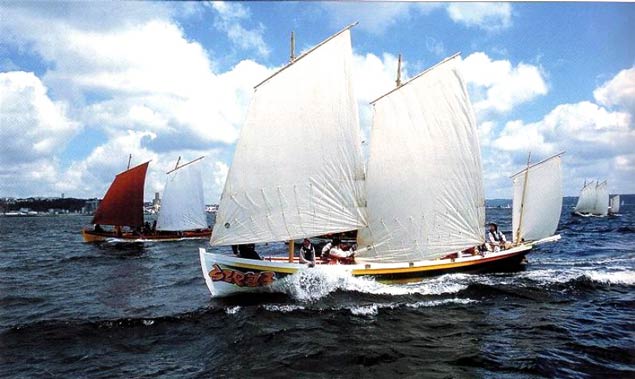 Revelling in it. The Bantry Boats get maximum enjoyment from the Morbihan festival.
Revelling in it. The Bantry Boats get maximum enjoyment from the Morbihan festival.
The current Festival of Sail on the Golfe de Morbihan in Southern Brittany (its proper name is Semaine de Golfe, but if we use that title, everyone expects Rory McIlroy to turn up) provides an ideal showcase for these lovely boats. Yet in a very mixed fleet which apparently is now approaching the 1500 mark, even the distinctive Bantry Boats can take a bit of finding.
It was the hawk-eyed Con Murphy (who’s taking part in the event with his wife Cathy MacAleavey in her new Jimmy Furey-built Water Wag Mariposa) who spotted the Bantry Boats as he ambled along the beach, and the image has winged its way to Afloat.ie.
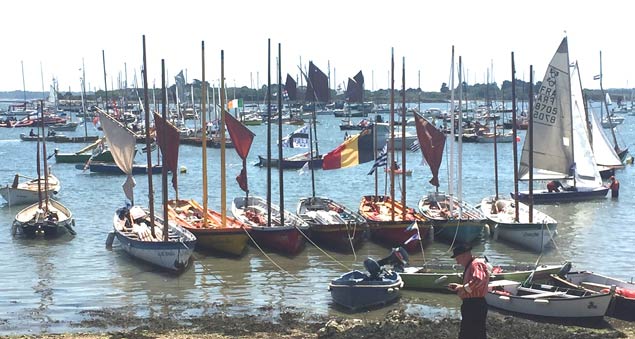 In a total fleet now approaching 1500 boats in the Morbihan, it took the hawk-eyed Con Murphy to spot the Bantry Boats bow-on and demurely at rest on the edge of the beach. Photo: Con Murphy
In a total fleet now approaching 1500 boats in the Morbihan, it took the hawk-eyed Con Murphy to spot the Bantry Boats bow-on and demurely at rest on the edge of the beach. Photo: Con Murphy
Meanwhile the Water Wags, far from letting themselves be dragged with indignity onto the beach, made for an impressive display in a neat row lying to a mooring, showing their gleaming brightwork to perfection. Those long off-season hours of preparation and sanding, and then varnishing when the temperature finally rose a little in the shelter of remote sheds in places like Kilpedder and Rogerstown, are this week paying big dividends on the international scene in South Brittany.
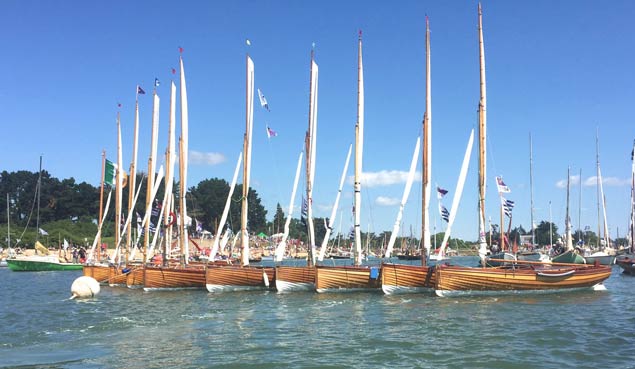 Shiny boats all in a row....The Water Wags looking their best in the Morbihan, an eloquent testimony to dedicated off-season hours of amateur preparation and varnishing. Photo: Con Murphy
Shiny boats all in a row....The Water Wags looking their best in the Morbihan, an eloquent testimony to dedicated off-season hours of amateur preparation and varnishing. Photo: Con Murphy
See more photos of the Morbihan Festival on Thierry Martinez's gallery here.
When you’ve 1400 sailing boats gently milling about, all in seemingly amiable confusion but with lots of warm sunshine, it’s an achievement to avoid a collision, and it’s a real breakthrough when you can recognise another participant writes W M Nixon.
For the 20 vintage Irish boats taking part in the Morbihan Festival of Sail in France – 14 Water Wags and six Howth Seventeens – yesterday’s opener with the inaugural Parade of Sail provided a flavour of what’s to come throughout the week. And last night, those whose boats didn’t provide some sort of overnight accommodation found themselves locating their homes for the week among hundreds of other shore-wandering sailors who’d spent the day being enchanted at the sight of so many boats of so many different shapes and sizes.
For that’s what the Morbihan Festival is ultimately all about. It’s an endless visual feast for all boat nuts of the true sailing kind. On the first day, you just keep gazing around you in wonderment. But after a while, you can even start on a bit of specific identification and analysis. That will begin today Tuesday – Day 2.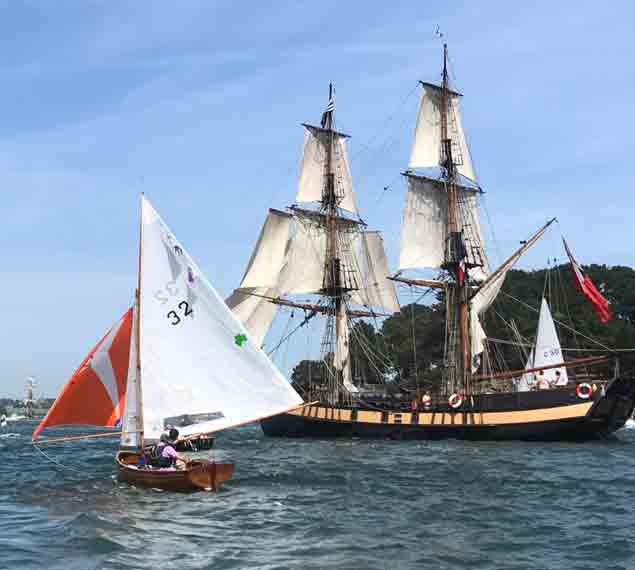 The 1985-built Water Wag Skee (named in honour of legendary boat-builder Skee Gray) shows a bit of racing experience with an effectively setting spinnaker and some interesting company
The 1985-built Water Wag Skee (named in honour of legendary boat-builder Skee Gray) shows a bit of racing experience with an effectively setting spinnaker and some interesting company
It’s probably more than a little sacrilegious to suggest that, as some of the rituals of a global religion are built around The Last Supper, then it’s not at all unreasonable for the world’s oldest One-Design sailing class to have its rituals built around The First Picnic writes W M Nixon.
But the thought springs irresistibly to mind on seeing the first image of the Dublin Bay Water Wags settling into their new home for the week, southern Brittany’s incomparable inland sea of the Morbihan, currently en fete with a fleet of 1400 craft of all sizes for the biennial Festival of Sail which has been getting under way today.
The Dublin Bay Water Wags make up just 1% of the fleet, with fourteen boats present. But that’s not bad going for a class founded in 1887. Admittedly the boats now in France are of a type introduced to the class in 1900, yet that still makes them older than most other boats present, though not the two Howth 17s Leila and Aura of 1898 vintage, there in France with four other newer boats of their class
It was when the two Irish classes finally met up today that the Water Wags were found having a picnic. Not a very organized one admittedly, and definitely not Glyndeburne style, as it was little more than a lunch stop at a handy beach.

The First Picnic. Midsummer’s Day 1887, and the Water Wags (of the original 13ft type) are gathering at Dalkey Island. Photo courtesy Water Wags
Nevertheless it sparked thoughts of The First Picnic, which was held on Dalkey Island on Midsummer’s Day, June 21st 1887, when the Water Wags were in their first year, and were sailing the little double-ended 13ft dinghies that were the basis of the class for their first dozen years.
It was combined with a “cruise” from what was then Kingstown Harbour to celebrate Queen Victoria’s Golden Jubilee. And as the photos from Alfred & Vincent Delany’s excellent history of the Water Wag class reveal, Victorian picnics were not something to be undertaken lightly. This is Serious Fun in a tradition which the class have continued ever since. So they’ll probably be very offended by any thought that this photo just in from the Morbihan suggests for even a nano-second that they’re having a picnic.
 These are Serious Picnic People – the Water Wag Class members and guests on Dalkey island, June 21st 1887. Photo courtesy Water Wags
These are Serious Picnic People – the Water Wag Class members and guests on Dalkey island, June 21st 1887. Photo courtesy Water Wags
Classic Dublin Bay 24 Yacht to Return to Dun Laoghaire
The last time the Alfred Mylne-designed Dublin Bay 24s raced together in their home waters was Saturday, September 25th 2004 writes W M Nixon. Since then, the class has been through various traumas as projects for a group rebuild/restoration in France fell victim to the financial crisis.
However, the boats were kept in store, and two years ago a complete re-build programme for one of them, Periwinkle, was put into action at Skol ar Mor, the pioneering boat-building school in South Brittany run by Mike Newmeyer.
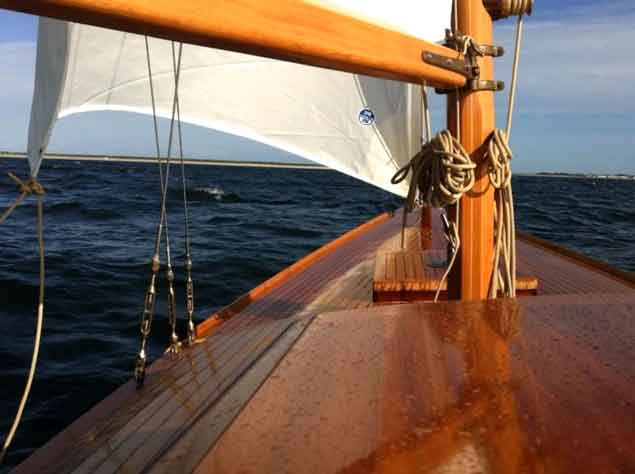 Sailing aboard the restored Periwinkle. The quality of the bronze fittings on the mast matches the high standard of the restoration. Photo Brian Mathews
Sailing aboard the restored Periwinkle. The quality of the bronze fittings on the mast matches the high standard of the restoration. Photo Brian Mathews
Perwiwinkle has turned all heads any time she goes sailing, but there’s no doubt she’d make most impression in an active class setting. As it is, for this year’s Morbihan Festival of Classic and Traditional Boats in the last full week of May, she’ll be sharing the waters of that noted inland sea with boats from home, as twelve Dublin Bay Water Wags and eight Howth Seventeens are being trailed, ferried, and trailed again to take part in one of the greatest gathering of character boats in the world.
 Water Wags in festive mode for their 125th Anniversary in 2012 at Dun Laoghaire Harbour mouth. In ten days time, 12 of them will be in France en route to the Morbihan Festival
Water Wags in festive mode for their 125th Anniversary in 2012 at Dun Laoghaire Harbour mouth. In ten days time, 12 of them will be in France en route to the Morbihan Festival
But while the Water Wags and the Howth Seventeen will be sailing in the enormous fleet, Periwinkle will be on static display afloat, alongside the Skol ar Mor booth at the boat show in the port of Vannes at the head of the Morbihan, though there is a possibility that renowned designer Francois Vivier will take her out for a sail. Happily, though, she’ll soon definitely be sailing – and she’ll be sailing to Dublin Bay.
Owners Chris Craig and David Espey are determined to get her back in time for the Classics Division in the Volvo Dun Laoghaire Regatta from 6th to 9th July, and will be sailing her up from Brittany with a target time of 1st July pencilled-in for arrival in Greystones. Their hope is that former DB24 sailors will then join them to sail on to Dun Laoghaire on Sunday July 2nd.
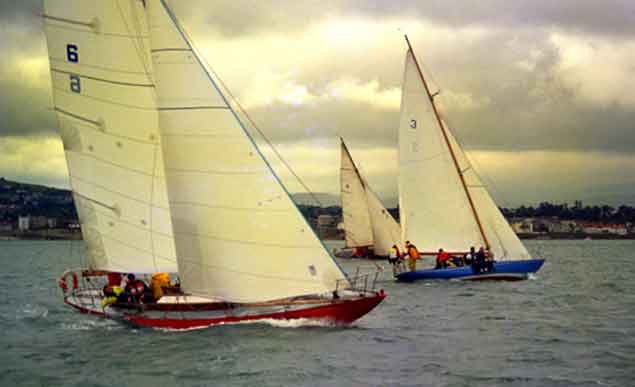 Class racing act. The Dublin Bay 24s in action at the Dun Laoghaire Woodenboat Regatta 1997. Photo: W M Nixon
Class racing act. The Dublin Bay 24s in action at the Dun Laoghaire Woodenboat Regatta 1997. Photo: W M Nixon
As for the rest of the DB24 fleet, their elegant yet tired hulls are finding new purpose in boat-building schools. In September, Adastra will go to Albaola Scholl in San Sebastian in northern Spain, Zephyra is being shipped across the Atlantic for the Apprentice Shop in Maine, and Arandora is to be completed in Les Atelier de L’Enfer in Douarnenez in Brittany. Mike Newmeyer is working on a plan for Euphanzel, and various proposals are being discussed regarding the future of Harmony and Fenestra.
It has been – and still is - a long and difficult journey. But the arrival of Periwinkle in Dublin Bay will surely be a very significant step
Irish Sailing's Classic Boats Get The French Morbihan Mystique
Three weeks hence from this morning, on Saturday May 19th, an unlikely convoy of vehicles with a very special collection of unique vintage boats and people will emerge in Cherbourg from Irish Ferries’ ship just in from Rosslare writes W M Nixon. Meanwhile, well to the west in northern Brittany, a similarly rare group with antique boats of a different type will have disembarked in Roscoff from the Brittany Ferries vessel from Cork. By that night, if all goes according to plan, both groups – people and boats alike - will be united a long way away, in the little port of Arradon on the shores of the Morbihan, the island-studded inland sea at the heart of its own Department, the most southerly part of Brittany.
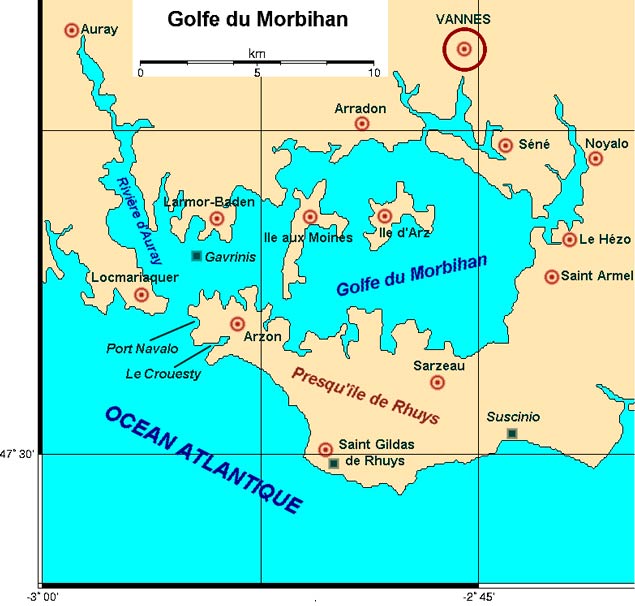 A sailing paradise. In detail, there are sixty islands in the Morbihan. The Irish crews in the Water Wags and Howth 17s will be based at Arradon on the north shore.
A sailing paradise. In detail, there are sixty islands in the Morbihan. The Irish crews in the Water Wags and Howth 17s will be based at Arradon on the north shore.
The Irish classic boats and those who sail them will have arrived to immerse themselves in the fleet of more than 1,300 other unusual craft in a very French celebration of sailing and pride in individualistic boat ownership. It’s a wonderfully complex biennial celebration which uses the magic waters of the Morbihan, where sea and land completely intertwine in the midst of the sweetest countryside with enchanting village ports, to provide a unique playground for boats of all types and sizes.
 The replica of Peter the Great’s 1703-built Shtandard will be one of the largest vessels at the Morbihan.
The replica of Peter the Great’s 1703-built Shtandard will be one of the largest vessels at the Morbihan.
At the time of writing, they’re expected to range in size from the extraordinary Russian re-creation of Peter the Great’s huge warship of 1703, the Shtandart, right down to a selection of the sometimes decidedly unusual yet effective little craft which emanate from the creative minds to be found in Francois Vivier’s design office. In between, we’ve everything from the America’s Cup 12 Metre France through a comprehensive selection of traditional sailing fishing boats and classic yacht from several maritime nations, and on through a goodly fleet of other traditional craft with a strong representation of the Bantry Boats, until at the lower end of the size scale, we find some little boats which are very odd indeed, owner-designed craft which can best be categorized somewhere on the scale which ranges from Rather Quirky to Utterly Bonkers.
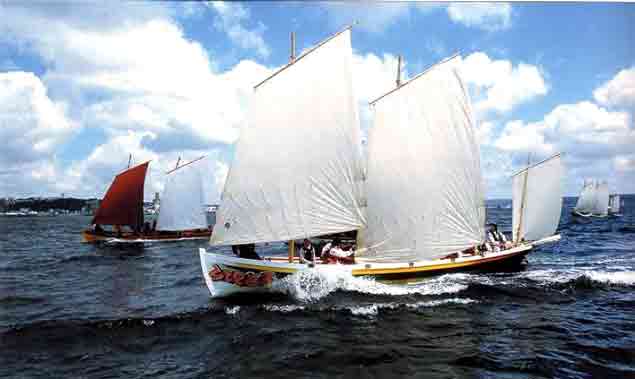 Bantry Boats racing in France. Based on the ship’s boat left behind in Bantry Bay after the failed invasion of 1796, the Bantry boat was stored for more than a hundred years at Bantry House before being moved to the National Museum. Under an iniative inspired by Hal Sisk, they are now the basis of a lively fleet on both sides of the Atlantic, and will be a feature of the Morbihan Week.
Bantry Boats racing in France. Based on the ship’s boat left behind in Bantry Bay after the failed invasion of 1796, the Bantry boat was stored for more than a hundred years at Bantry House before being moved to the National Museum. Under an iniative inspired by Hal Sisk, they are now the basis of a lively fleet on both sides of the Atlantic, and will be a feature of the Morbihan Week.
 They’re in better heart than ever. The Water Wags at a recent “training weekend” at Killenure on Lough Ree. Next month they will be making their second visit to the biennial Morbihan Week in southern Brittany.
They’re in better heart than ever. The Water Wags at a recent “training weekend” at Killenure on Lough Ree. Next month they will be making their second visit to the biennial Morbihan Week in southern Brittany.
In the midst of the huge fleet, there’ll be twelve Water Wags and six Howth 17s from Ireland. Small and all as they are by comparison with some of the enormous traditional fishing craft and Tall Ships taking part, they will be accorded honoured status partly on account of age. The Water Wags of 1887 origin, with the present class a re-worked larger design from 1900, introduced the One-Design concept. And as the Howth 17s are of 1898 origin, they are accorded the special honour of being the world’s oldest one design keelboat class still sailing as originally designed.
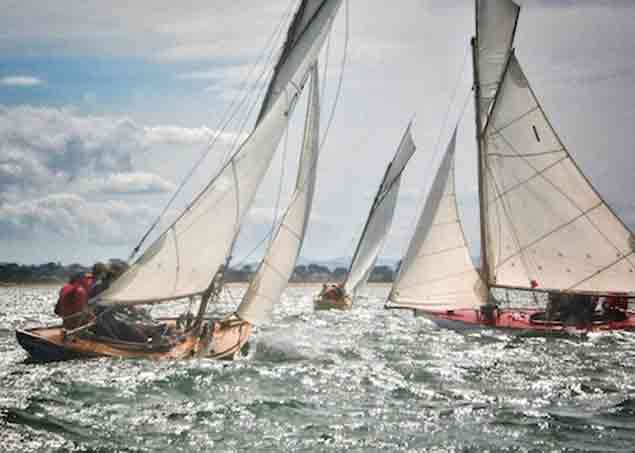 Howth 17s in full cry. They will be making their first visit to the Morbihan festival, but their newest sister-ship is being built nearby at Skol ar Mor.
Howth 17s in full cry. They will be making their first visit to the Morbihan festival, but their newest sister-ship is being built nearby at Skol ar Mor.
Further to all that, both classes bring international status through coming from Ireland, and few have come further, even if the little Irish boats are sensibly using the ferries. But we will also see Irish Sea representation with boats which have sailed there, with the beautifully restored classic Laurent Giles-designed Carbineer 46 Sylvana voyaging from Northern Ireland, while the irrepressible Joe Pennington from the Isle of Man is entered with his restored 1895-built 36ft Manx longliner Master Frank, which might find it interesting to have a spot of competition with the comparable French-based Essex smack Unity of Lynn.
However, for the little Irish boats, it’s a formidable logistical challenge. The Water Wags - in which the Olympic Mother Cathy MacAleavey has been setting the racing pace of late, though David MacFarlane won on Wednesday – are in good hands as Carol O’Rourke is coordinating their arrangements. But anyway they’ve useful experience here, as seven of them travelled to the 2015 Semaine du Golfe du Morbihan, and eight came back. They returned with a new boat for Adam Winkelmann which had been built to the class’s ancient designs by Mike Newmeyer and his team at the inspirational boat-building school Skol ar Mor.
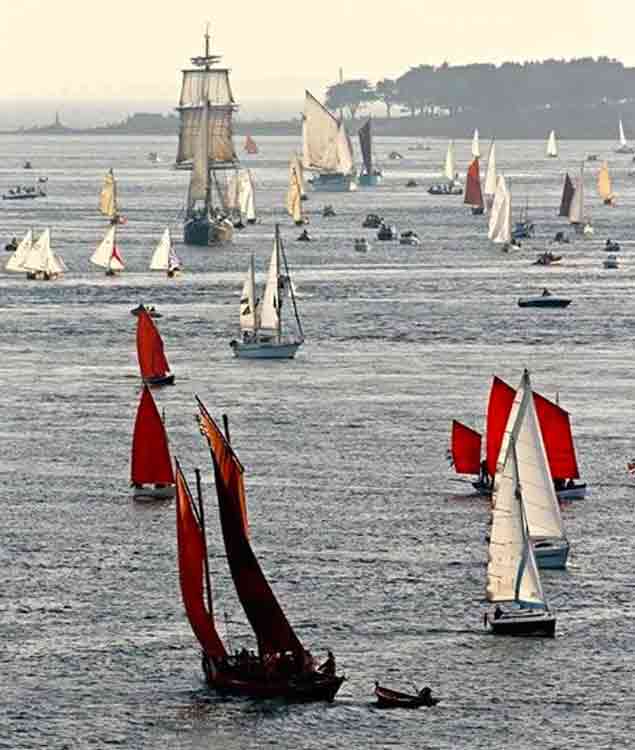 Eclectic fleet......the Morbihan Fesitval in 2015. Four of the Water Wags are just about visible left centre
Eclectic fleet......the Morbihan Fesitval in 2015. Four of the Water Wags are just about visible left centre
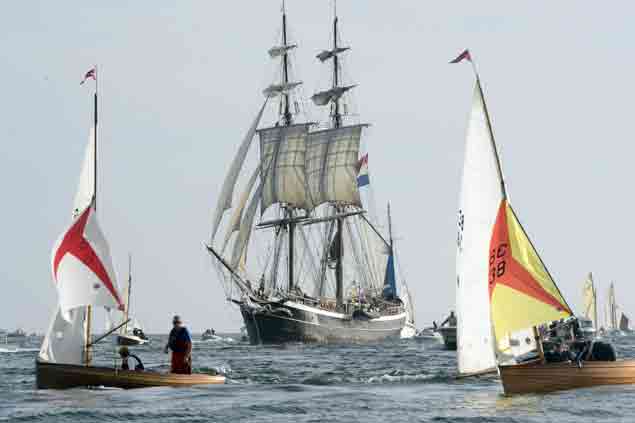 The popular Dutch sail training ship Morgenster was a welcome visitor to the festival in 2015, and is seen here approaching the entrance to the Morbihan in company with a couple of Water Wags
The popular Dutch sail training ship Morgenster was a welcome visitor to the festival in 2015, and is seen here approaching the entrance to the Morbihan in company with a couple of Water Wags
Skol ar Mor – which is located near the entrance to the Morbihan – is currently building a new Howth 17 for Ian and Judith Malcolm, but she won’t be finished until July as her construction is timed to phase in with the school’s term periods. But in any case, the Malcolms are keen to make their debut for the Howth 17s at Morbihan with their 1898-vintage boat Aura, which they’ve owned, lovingly cared for and raced very regularly since 1980.
It’s not the first time the Howth 17s have travelled far from their ancestral home, in fact it’s not the first time they’ve been to France, as a trio went to the Brest Festival in 1972. But road travel technology for little old boats wasn’t so advanced 45 years ago, so it wasn’t until 1998 that another road migration was taken on, with seven of them going to Belfast Lough to celebrate their centenary at their birthplace at Carrickfergus. They sailed the 90 miles home.
Then in 2005 they’d a seriously major movement, when an incredible 15 managed to get to the Glandore Classics involving an efficiently-organised set of low loaders which could take the boats down to West Cork three or even four at a time.
The Howth 17s are nothing if not individualistic, so the regimentation essential to the success of this expedition was exhausting for them. It took a while for the normal busy season of racing (usually they’ve sixty races a year) to resume once they’d got home. So since then, they’ve been building up a group of owners within the class who have proper road trailers, and that was the means used to get seven boats to Belfast Lough for last year’s 150th Anniversaries of Carrickfergus Sailing Club and Royal Ulster Yacht Club, together with the celebration of the yacht and boat-building achievement of the John Hilditch yard at Carrickfergus.
 The opportunity to compare different rigs and boat types at the Morbihan is unrivalled. This is the Looe Lugger Our Boys of Plymouth..........
The opportunity to compare different rigs and boat types at the Morbihan is unrivalled. This is the Looe Lugger Our Boys of Plymouth..........
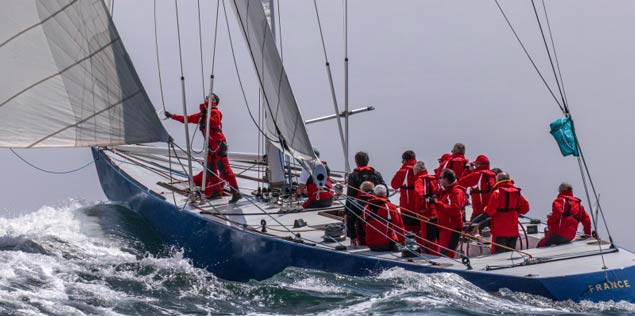 ......and this is the former America’s Cup 12 Metre France
......and this is the former America’s Cup 12 Metre France
But there’s a heck of a difference between taking just part of a morning to road-trail mostly on motorways from Howth to Bangor, and trailing your boat from Dublin to the Morbihan via the Rosslare-Cherbourg ferry. The Water Wags know they can do it, but for the much heavier Howth 17s and their interesting selection of four-wheel-drive towing vehicles, they’re facing a total haul of 540 kilometres, 348 of them in France.
Naturally, there are those who’ll say that boats of this vintage should live pampered lives. But the Howth 17s are nothing if not adventurous, and Irish Ferries have been so much taken with all this that four of the boats and their towing vehicles are travelling the ferries there and back for free, so between them the six travelling equipes have only had to divvy up for two boats’ cost.
Nevertheless as two of the boats – Aura and Roddy Cooper’s Leila - are from the original 1898 Hilditch-built five, they’re moving a uniquely precious cargo on a project very far removed from their origins. So far removed, in fact, that I can’t help but imagine John Hilditch urging on his men on a Monday morning early in the Spring of 1898 with the inspiring words: “C’mon, lads, we have to build these new Howth boats strong and true, for in 119 years time their owners will want to trail them the 217 miles from Cherbourg to Vannes on some sort of road cart.”
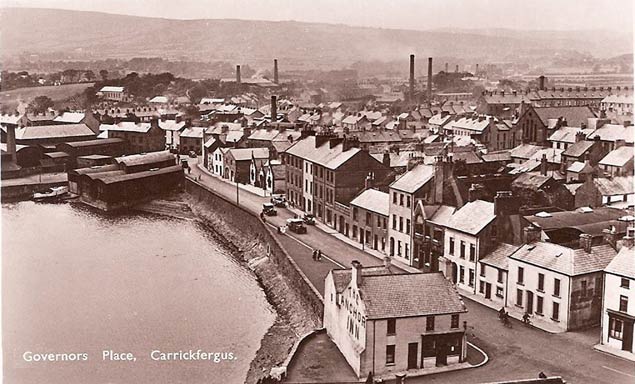 Change of scene. The Howth 17s were built in Carrickfergus in 1898 in Hilditch’s Boatyard in those black sheds on the waterfront at the head of the harbour in an industrial town.......
Change of scene. The Howth 17s were built in Carrickfergus in 1898 in Hilditch’s Boatyard in those black sheds on the waterfront at the head of the harbour in an industrial town....... ....but next month they’ll be sailing in these agreeable surroundings in the heart of the Morbihan
....but next month they’ll be sailing in these agreeable surroundings in the heart of the Morbihan
Quite. Either way, it will be an exhausting journey, but it’s the sort of project which re-energises those involved as it moves along, and once they’ve got to the Morbihan, the Water Wag and Howth 17s sailors will find themelves among kindred spirits. It’s something they need from time to time. Only the other day I was asked to reveal to a non-sailor what the Water Wags are all about in 2017, and found it very challenging. For how can you explain the inexplicable?
Around the Morbihan, there’ll be no need to explain. Yet even in France supposedly among members of the same nautical religion, the Howth 17s and the Water Wags will find themselves slightly at odds with the crew of some other boat types, as the essence of both the Irish classes is that they race a lot, so much so that both classes are healthier than ever. But that is not always to the taste of all those who simply love old boats for themselves, and find that keeping them in good order and sailing them in non-competitive style on various expeditions within the ambit of the Semaine du Golfe du Morbihan is all that is required.
But the Morbihan has so much to offer that there’s something for everyone, and for smaller racing boats that want racing, there’ll be racing available. As for others who simply like sport in sailing challenging bits of sea, the tides in the Morbihan whoosh in and out through the narrow entrance with such vigour that many treat it like a nautical ski slope.
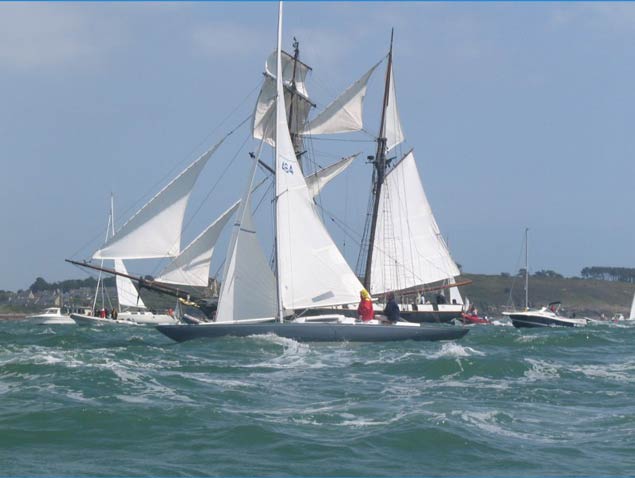 The manageable liveliness of the tide-riven waters in the Morbihan entrance is integral to the way the event is staged.......
The manageable liveliness of the tide-riven waters in the Morbihan entrance is integral to the way the event is staged.......
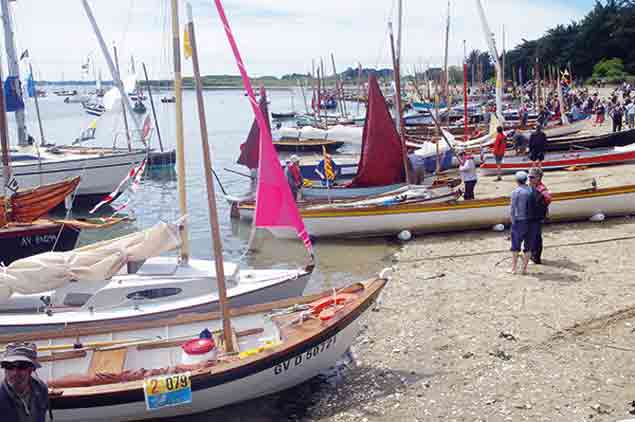 ......but for balance, sheltered beach time is expected
......but for balance, sheltered beach time is expected
This is markedly unlike the attitude at the entrance to Strangford Lough. There, the tide-race on the bar is admittedly on a bigger scale, but it’s regarded as something to be avoided. At the Morbihan by contrast, there are small boat sailors who’ll spend their whole day crawling in the eddies against the tide, and then returning with it in the middle of the full exuberant burst of the rip.
For those with more leisurely tastes, there are all sorts of waterside establishments where lunch can go on for ever, but be very sure to have secured your table by 12:30pm. And as for visiting other boats, that too can go on for ever.
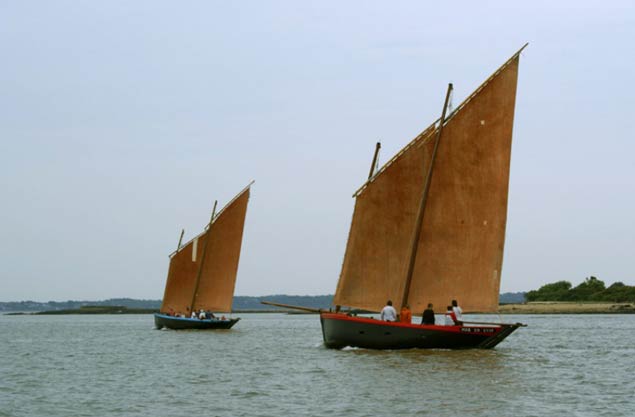 The sinagot is the indigenous traditional fishing boat of the Morbihan
The sinagot is the indigenous traditional fishing boat of the Morbihan
Certainly there are some with which the Howth folk should link up. A noted presence will be the McGruer 8 Metre Cruiser/Racer Orana of 1959 vintage. For many years she was based in Howth under Johnny Pearson’s ownership, and she had her moments, including winning the 1966 RORC Beaumaris-Cork Race overall. She was the first yacht I ever did the Lambay Race aboard, and when you do your first Lambay Race with the likes of Johnny Pearson, Bob Fannin and Brendan Murray, you learn an awful lot about what living in Howth is going to involve, and you even learn a little about racing round Lambay.
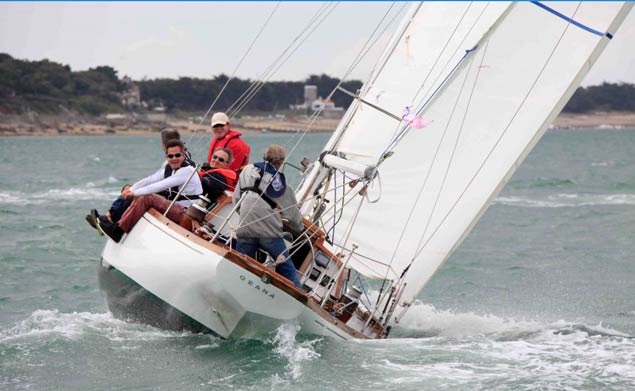 The 1959 McGruer-designed 8 Metre Cruiser-Racer Orana was Howth-based for many years, and was overall winner of the 1966 RORC Beaumaris-Cork Race. After being under the radar for decades, she has re-emerged in French ownership as a participant at Morbihan Week 2017
The 1959 McGruer-designed 8 Metre Cruiser-Racer Orana was Howth-based for many years, and was overall winner of the 1966 RORC Beaumaris-Cork Race. After being under the radar for decades, she has re-emerged in French ownership as a participant at Morbihan Week 2017
Orana had been off the radar for decades, but now she has re-emerged, spic and span in French ownership and ready to strut her stuff in the Morbihan in three weeks time when she’ll be part of a mind-blowing feet. In fact, so diverse is the fleet, that while most of it will be the challenge of recognising what’s going past, some are worth seeking out directly, and one such is surely the famous Pen Duick, Eric Tabarly’s original boat, a Fife-designed 15-tonner which started life in 1898 at Carrigaloe on Cork Harbour.
Originally, she was given the unlovely name of Yum, and her owner, one Adolphus Fowler of the Royal Munster YC, was evidently feeling prosperous, for at the same time he had the Carrigaloe yard built him the Cork Harbour One Design Jap.
Both boats still sail the sea, but mercifully Yum soon received a pleasanter name as she was quickly sold, and she is now immortalised as Pen Duick, the eternal beauty brought back to life by Eric Tabarly to be an extraordinary link between William Fife of Scotland, Cork Harbour in Ireland, and all that is best in French sailing in Brittany.
In a league like this, the little boats from Ireland will need to do something special to fulfill their role. But I think that the poster that the Howth 17s commissioned from local artist Carol O’Mara for display on the various sites around the Morbihan is definitely a step in the right direction. There’ll be so many messages flying around from all sources that something which says what it wants to say so well, so simply, and so directly will make the most impact.




























